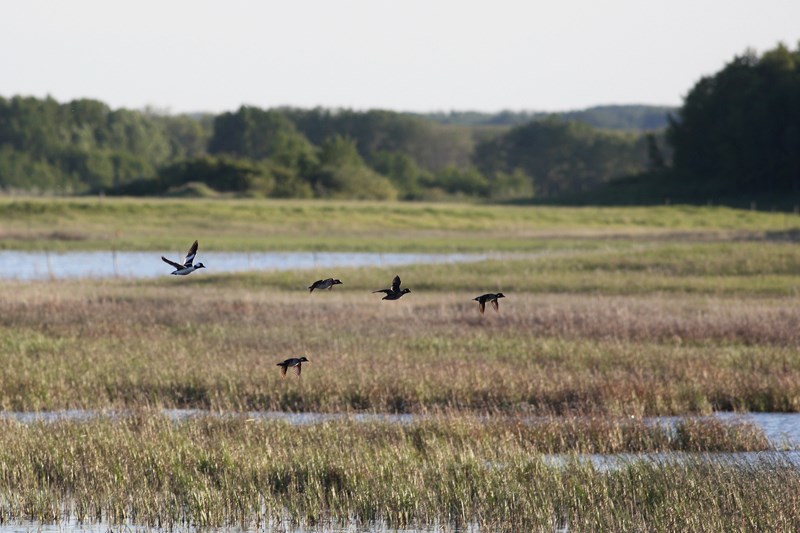The Nature Conservancy of Canada (NCC) has purchased 65 hectares (160 acres) which contains ecologically significant wetland habitat two kilometres north of Good Spirit Provincial Park.
The land was deemed a priority conservation site by NCC because of its proximity to the provincial park and because of the threat of increasing habitat loss in the area.
“The property, known as Spirit Creek, is located in a North American Waterfowl Management Priority Area. It supports a number of species of waterfowl during breeding and migration, including northern shoveler and blue-winged teal, as well as a diversity of other birds and wildlife. The forest and shoreline habitat provide important shelter and foraging for moose, with the wetlands also providing additional valuable benefits, such as flood control, improving air quality and restoring ground water,” detailed an NCC release.
“The conservation of the Spirit Creek property not only protects wetlands but it increases the connectivity of important habitat for species identified in the area, including black bear, deer, elk and moose.”
Jesse Nielsen, Manager of the Assiniboine Watershed Stewardship Authority told Yorkton This Week the project being local is important.
“Anytime you can help preserve and protect natural habitat in the Assiniboine Watershed it’s a big win for the overall health of our watershed,” he said.
“In terms of Source Water Protection, our association’s mandate, the more ‘natural’ a landscape is, the less threats to our drinking water sources, be it surface or groundwater, and the more benefits that are being provided because of those natural areas; benefits such as groundwater recharge and drought buffering by wetlands, sediment and erosion capture from healthy riparian areas, and habitat for many plants and animals. In today’s heavily-modified prairie landscape, it’s great to see organizations such as NCC taking a role in ensuring that natural areas such as that of the Spirit Creek property will remain part of the Assiniboine River Watershed for residents to enjoy and benefit from now and for our future generations to come.”
Catherine McKenna, Federal Minister of Environment and Climate Change said the purchase helps protect the environment in the local region.
“On World Wetlands Day (Feb. 2), our Government congratulates the Nature Conservancy of Canada on conserving 65 hectares of important wetland and forest habitat in Saskatchewan through the Natural Areas Conservation Program. By working together we can all help protect Canada’s biodiversity and wild spaces for future generations,” she said in the release.
Canada is a signatory to the Convention on Wetlands of International Importance, also called the Ramsar Convention, an intergovernmental treaty that provides the framework for national action and international cooperation for the conservation and wise use of wetlands and their resources. World Wetlands Day is celebrated every year on February 2 to mark the 1971 adoption of the Convention on Wetlands in Ramsar, Iran; 88 per cent of United Nations’ member states have become contracting parties to the Convention on Wetlands.
“Thirty per cent of revenue from all fur, angling and hunting licences is used to manage, preserve and enhance habitat through the Fish and Wildlife Development Fund,” said provincial Environment Minister Dustin Duncan in the release. “Lands purchased with these funds can be used by everyone including local hunters, cottagers, hikers, bird watchers and photographers. The Spirit Creek property builds on nearby park and Crown pasture lands, and maintains the natural values that make the Good Spirit Lake area such a popular recreational destination. We commend Nature Conservancy of Canada on this new acquisition and appreciate their continuing contributions as a valued partner in the Development Fund.”
Cameron Wood, program director central/southeast for the Nature Conservancy of Canada in Saskatchewan agreed the purchase was a wise move.
“The acquisition of our new Spirit Creek property is an important step forward in conserving the diversity of plants and wildlife that make this part of Saskatchewan special,” he said in the release. “The habitat on the property and in the surrounding area is important for waterfowl, black bear, elk and moose as well as the natural vegetation that helps to support the biodiversity of the area. We look forward to undertaking more intense inventories of the property and stewarding it into the future.”
The next step is for NCC biologists to complete a thorough inventory of the property this spring.
“The inventory will include identification and confirmation of the animals and plants located on the land. This information will be used to develop a property management plan to ensure this land is managed responsibly into the future,” states the release.
The NCC does provide public, on-foot access at almost all of our properties, including the Spirit Creek property.
The Spirit Creek conservation project was made possible through financial contributions by a number of partners. They include the Government of Canada through the Natural Areas Conservation Program, the Government of Saskatchewan through the Fish and Wildlife Development Fund, and the U.S. Fish and Wildlife Service through the North American Wetlands Conservation Act, along with many individual donors and supporters.
The Nature Conservancy of Canada (NCC) is the nation’s leading not-for-profit, private land conservation organization, working to protect our most important natural areas and the species they sustain. Since 1962, NCC and its partners have helped protect more than 1.1 million hectares (2.8 million acres), coast to coast. In Saskatchewan, NCC has conserved over 60,700 hectares (150,000 acres) of ecologically significant land through land donations, purchases and conservation agreements.
The Government of Canada’s Natural Areas Conservation Program (NACP) is a unique public/private partnership to accelerate the pace of land conservation across southern Canada. The Nature Conservancy of Canada (NCC) manages the program. Federal funds are matched by contributions raised by NCC and its partners. Habitat conserved under the NACP enhances natural corridors and other protected areas.



